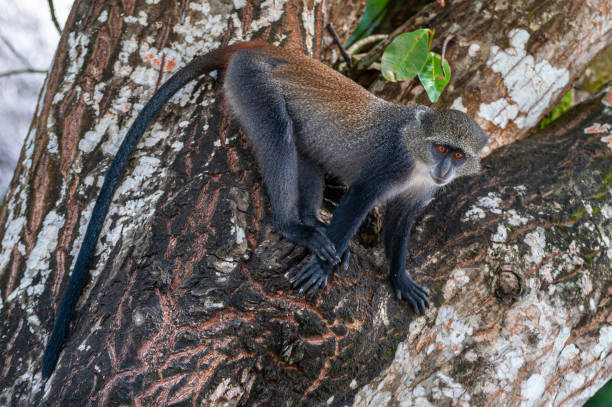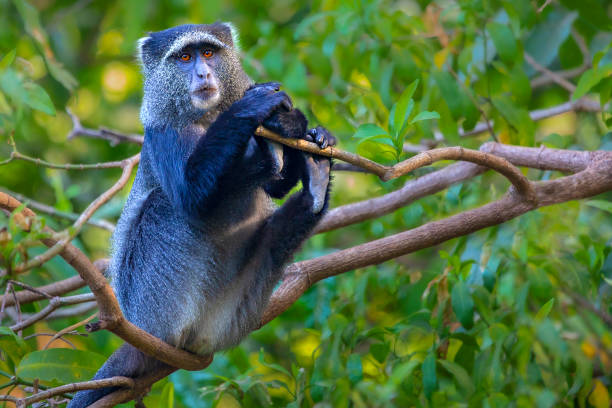Table of Contents
Scientific Classification
| Kingdom | Animalia |
| Phylum | Chordata |
| Class | Mammalia |
| Order | Primates |
| Family | Cercopithecidae |
| Genus | Cercopithecus |
| Species | C. mitis |
| Scientific Name | Cercopithecus mitis |
1. Description
You might think Blue Monkeys are actually blue based on their name, but that’s not quite the case. Their fur can appear bluish-gray in certain lighting, but it’s really just an optical illusion created by a mix of black and gray hair with some golden highlights. They have a slender build and a petite face, often sporting a white or yellowish patch on their throat that gives them a rather contemplative expression.
Adult males tend to be larger, weighing in at about 8 kg (17.6 lbs), while females are smaller, around 4 kg (8.8 lbs). Their bright, inquisitive eyes and playful behavior draw in both researchers and wildlife lovers alike.
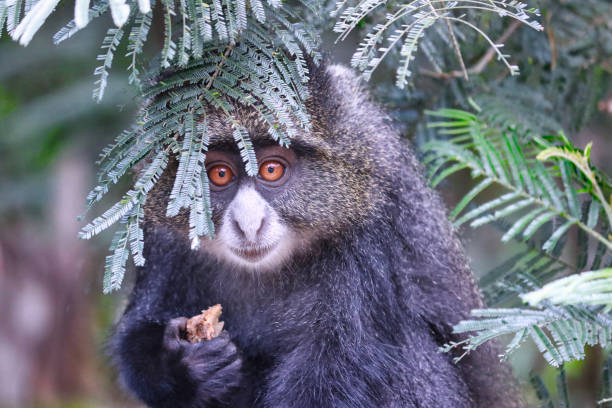
2. Distribution
When it comes to distribution, Blue Monkeys are found across Central and East Africa. You can spot them in places like the Congo Basin, Kenya, Rwanda, Uganda, Tanzania, and even parts of Angola and Zambia. They’re among the most widely spread members of the Cercopithecus genus.
These monkeys are quite adaptable and can thrive in different types of forests, as long as there’s plenty of canopy cover. However, their populations aren’t evenly distributed; how many you find in a given area really depends on the health of the forest and the impact of human activities nearby.
3. Habitat
Blue Monkeys have a strong preference for lush, moist forest environments, often making their homes in evergreen and montane forests. They really enjoy hanging out in the mid and upper levels of the forest canopy, where they spend plenty of time foraging, resting, and socializing with one another.
You can find them in bamboo forests, along riverine woodlands, and occasionally in secondary forests. They can adapt to disturbed habitats as long as there’s some vertical structure and enough food sources available.
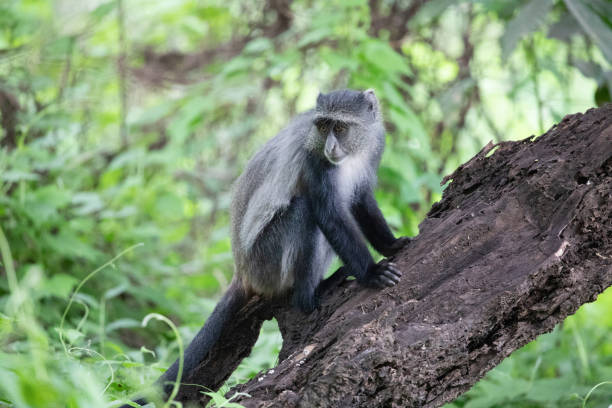
4. Diet
Blue Monkeys have a pretty interesting diet! They mainly munch on fruits, which is why we call them frugivorous. But they’re not picky eaters; they’ll take advantage of whatever food is around, including:
– Delicious fruits, especially figs and wild berries
– Tender leaves and young shoots
– Colorful flowers and buds
– Tasty insects like caterpillars and grasshoppers
– Occasionally, they might snack on small reptiles or bird eggs
This diverse menu allows them to stick around in one spot for quite a while, as they adapt to whatever seasonal goodies are available.
5. Behavior
Blue Monkeys are quite the social creatures, often gathering in matrilineal troops that can range from 10 to 40 members. These groups typically consist of several females, their young ones, and a dominant male who takes on the role of protector and holds the breeding rights.
When it comes to communication, they have a rich repertoire that includes vocal sounds, facial expressions, and body language. One of their signature vocalizations is the “boom” call—a deep, resonant sound that males use to assert their territory and display dominance.
Unlike some other monkeys, Blue Monkeys prefer the trees to the ground. They only venture down when absolutely necessary. Most of their daily activities, like feeding, grooming, and playing, take place high up in the branches.
The females in these troops form strong bonds, often engaging in grooming as a social activity. This not only helps to reinforce their social hierarchies and alliances but also strengthens their relationships. Meanwhile, the juveniles indulge in play, which is crucial for their social development and motor skills.
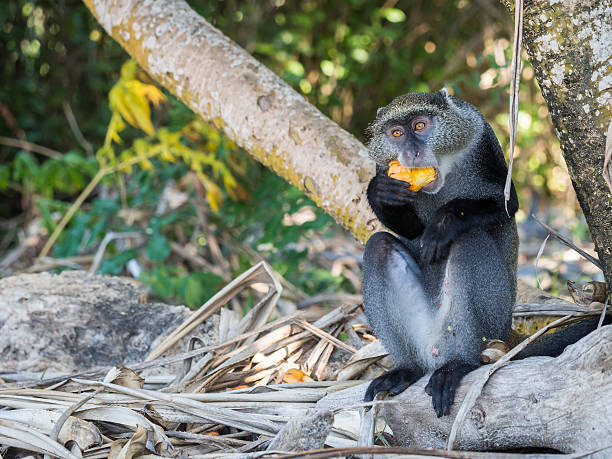
6. Lifespan
In the wild, Blue Monkeys can live for up to 20 years. This depends on factors like predation risk, disease, and food availability. In captivity, they can live up to 25 years. This is thanks to regular food, medical care, and no predators.
Females usually outlive males. Males might take risks when they defend their group or compete for dominance.
7. Reproduction and Lifecycle
Blue Monkeys tend to breed throughout the year, although there can be a slight uptick in mating activity depending on local conditions. The process usually kicks off with the female displaying specific body postures and vocalizations to signal her readiness.
After a gestation period of about 5 to 6 months, the female gives birth to a single infant. These little ones cling to their mothers, receiving all the care they need during those crucial first weeks. As they grow, the infants start to engage with other members of the troop, particularly the younger ones.
Weaning typically happens between 6 to 12 months, but the young monkeys often stay close to their mothers for several years. Once males reach maturity, they leave their birth group to prevent inbreeding and to seek out new social circles. Meanwhile, females usually remain with their original troop, which helps maintain stability within the group.
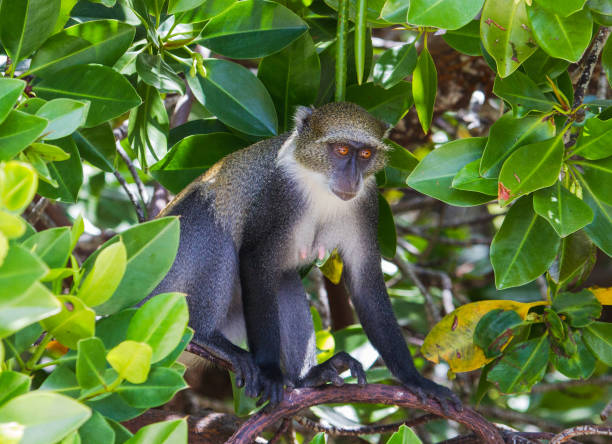
8. Predators
The Blue Monkey’s main natural predators include:
- Leopards
- Crowned eagles
- Pythons
- Humans (indirectly, through habitat destruction or bushmeat hunting)
To avoid predation, Blue Monkeys rely on their agility in the trees and group alert systems. When sentinels in the group see a threat, they make alarm calls. This alerts the group to flee or hide.
Infants are very vulnerable. They are often kept near their mother or older siblings for protection.
9. Adaptations
The Blue Monkey boasts a variety of physical and behavioral traits that enable it to thrive in the forest:
Prehensile Feet and Hands: These adaptations allow them to move through the dense canopies with impressive agility.
Coloration: Their camouflaged fur helps them seamlessly blend into the shadows of the forest.
Vocal Communication: With a wide range of calls, they maintain social bonds and alert each other to potential predators.
Dietary Flexibility: Their ability to consume fruits, leaves, insects, and more allows them to adapt to various conditions.
Matrilineal troop structures play a crucial role in maintaining social stability and fostering group learning, particularly among the young.
These adaptations have equipped them to succeed in a challenging and ever-changing environment, though threats still loom.
10. Conservation Status
According to the International Union for Conservation of Nature (IUCN), the Blue Monkey is currently classified as Least Concern. This reassuring status is largely due to its wide distribution and its knack for thriving in various types of forests.
That said, local populations are facing some serious challenges, including:
Deforestation: Driven by agriculture, logging, and urban sprawl.
Hunting: Particularly in regions where bushmeat is a common food source.
Pet Trade: While not widespread, some individuals are captured and sold illegally.
Human-Wildlife Conflict: As people move into forested areas, the competition for space and resources becomes more intense.
Conservation efforts are honing in on three main areas:
Protecting habitats.
Strengthening anti-poaching laws.
Raising awareness in communities about the vital role these primates play in the ecosystem.
Establishing protected areas, such as national parks and reserves, is essential for ensuring their future.
Conclusion
The Blue Monkey is a lively part of Africa’s incredible biodiversity. While it might not get as much attention as some of the more popular animals, it plays a crucial role in forest ecosystems. These monkeys are essential for seed dispersal and keeping insect populations in check. Their intelligence, social nature, and ability to adapt make them fascinating and important for the well-being of their environment.
As caretakers of our planet, it’s up to us to ensure that creatures like the Blue Monkey can flourish. Their future depends on our ability to live in harmony with nature, commit to strong conservation efforts, and protect their natural habitats.
